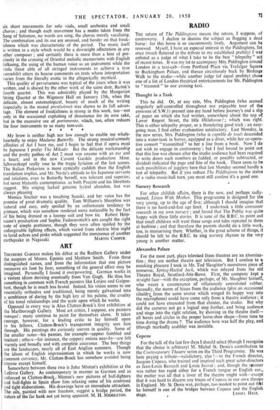ART
THEODORE GARMAN makes his debut at the Redfern Gallery under the auspices of Messrs. Epstein and Matthew Smith. From these
distinguished names, and from the information that one picture measures six foot by four, something of the general effect may be imagined. Personally I found it overpowering. Garman works in a violent idiom deriving eventually from Van Gogh. He thus has something in common with French painters like Lorjou and Guigne- bert, though he is much less brutal. Indeed, his vision seems to me essentially orthodox and traditional, being merely galvanised into a semblance of daring by the high key of his palette, the crudity of his tonal relationships and the scale upon which he works.
Opposed in every way is Alan Clutton-Brock's first exhibition at the Marlborough Gallery. Most art critics, I suppose, are painters manque ; many continue to paint for themselves alone. It takes courage, however, for a leading critic to lay himself open to his fellows. Clutton-Brock's transparent integrity sees him through. His paintings ate curiously uneven in quality. Some of the smaller notes—his pansies, for example—appear fumbled and hesitant ; others—for instance, the coppery onions near-by—are felt warmly and broadly and with complete assurance. The best things are the landscapes, nearly all of East Anglian summers. Though the idiom of English impressionism in which he works is now common currency, Mr. Clutton-Brock has somehow avoided being anyone except himself. Somewhere between these two is John Minton's exhibition at the Lefevre Gallery. As contemporary in manner as Garman and as unforced as Clutton-Brock,\ Minton's new pictures of bull-fighters and bull-fights in Spain snow him relaxing some of his contrived and tight elaborations. His drawings have an immediate attraction. The oils, painted with new freedom, suggest a bridge period, the nature of the far bank not yet being apparent. M. H. MIDDLETON.


































 Previous page
Previous page